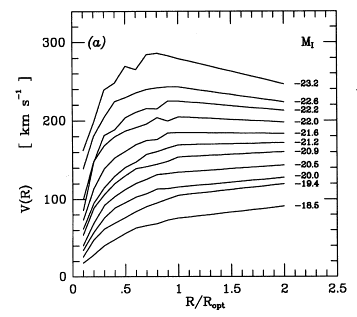- how you measure the velocity width. What is the circular velocity of these galaxies?
- the Hubble Type of the galaxies in question (Sa vs Sc for example).
- what wavelength you measure it in.

Remember what Tully-Fisher
says: luminosity and circular velocity are related
(ideally, L ~ v4). If we can calibrate this, and if we can measure
the circular velocity of galaxies, we can get their luminosity and distances.
(This is your homework problem #1...)
Problem #1: We don't understand the physics behind Tully-Fisher!
The Tully-Fisher relationship does not go like L~v4. It has subtle but important variations onProblem #2: Calibration.
- how you measure the velocity width. What is the circular velocity of these galaxies?
- the Hubble Type of the galaxies in question (Sa vs Sc for example).
- what wavelength you measure it in.
We need to get the absolute distances to a number of spiral galaxies in order to calibrate the T-F relationship. There aren't that many big spiral galaxies around that we have Cepheid distances to.
Problem #3: What kind
of galaxies does this work on? Where won't it work?
Take the fundamental plane
for ellipticals. Remember how we can permute all the variables around (L,
sigma, re, I). The fundamental plane can be permuted into:

So if we measure sigma and re, we can get L, the luminosity. This would be one possibility.
What is more commonly done is to define Dn as the physical radius (in kpc) inside which the average surface brightness of the galaxy is 20.75 in B. Assuming the ellipticals follow the R1/4 law, we can use the fundamental plane to show that
So if we can calibrate this, then all we need to do is measure the velocity dispersion and angular size within which I=20.75. Since we know from Dn-sigma what the physical size is, we can calulate the distance. This is called a standard rod measurement.
Advantage: its a way to measure distances to a large number of ellipticals.
Disadvantage: we don't understand the physics behind the fundamental plane.
Disadvantage: how do we calibrate it?
We need to get an absolute distance to an elliptical. Why is this hard?